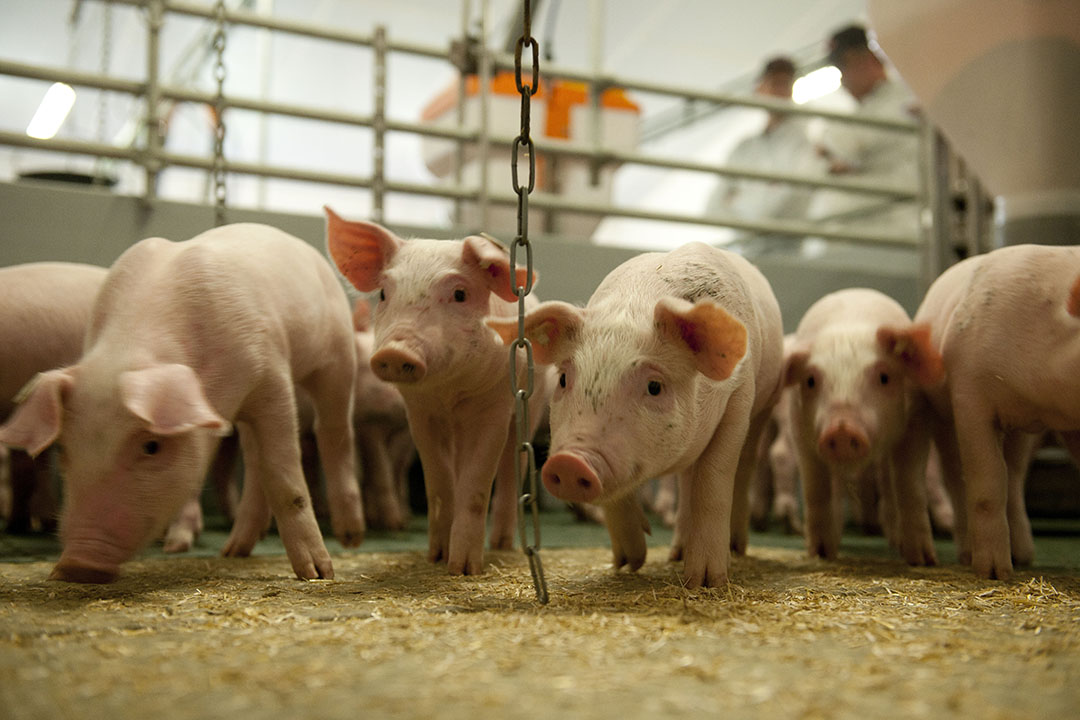Microbiome modulation: The benefits for swine

Prophylactic microbiome modulation and profiling pre-infection microbiome characteristics in swine provides a unique opportunity to consider possible avenues for how the microbiome can be used to prevent disease, US research has shown.
The gut microbiome is the term used to describe the collection of micro-organisms living in the gastrointestinal tract. These micro-organisms are vastly diverse, including viruses, bacteria, protozoa, fungi and archaea, and have been reported to equal or outnumber the cells of the host. Importantly, the gut microbiome plays a critical role in providing a protective intestinal barrier, digesting and metabolising nutrients, and developing, as well as maintaining, immunity.
As outlined in Figure 1, several factors and events impact the initial microbial exposure and colonisation of the piglet gut in the first few weeks of life, including birth route, the sow skin and faecal microbiome, diet while nursing and the transition to solid feed, housing and barn filtration, infection, antimicrobial exposure, and stress at processing. Often, these events can play a role in shaping the microbiome for the lifetime of a production pig. The relationship, balance and mechanistic interactions between these microbes in the gut is extremely complex and not well understood in states of health or disease. However, there is growing evidence indicating the beneficial role that gut microbiome diversity and composition play in the outcome of infectious diseases.
Figure 1 – Initial microbiome colonisation is impacted by several factors in the early life of a neonatal piglet. Interventions that affect these factors provide opportunities to shape the gut microbes towards having beneficial or detrimental characteristics.

Increasing interest in microbiome
Historically, the impact of the gut microbiome on infectious disease has focused on gastro enteric infections which cause diarrhoea, due to the seemingly inherent interactions of beneficial and pathogenic microbes in the gut. For example, pigs characterised as susceptible to enterotoxigenic Escherichia coli had a reduction in intestinal bacterial diversity compared to those pigs considered non-susceptible. More recently, the interest in the microbiome and its effects on infectious disease have expanded, to include pathogens primarily affecting the respiratory tract. As polymicrobial infectious respiratory disease is a major cause of morbidity and mortality in growing pigs, the gut microbiome has emerged as an alternative strategy in the control and prevention of these infections.
The gut-lung axis is the term used to describe how the gut microbiome, likely through products of microbial metabolism and modulation of systemic immunity, communicates with the respiratory tract and has the potential to affect outcomes following respiratory infections. Several published studies have shown a beneficial association between microbiome diversity and outcome following infection with viral, bacterial and even fungal respiratory pathogens in mice models of human disease. For example, increased gut microbial diversity has been associated with reduced mortality, decreased lung lesions, and enhanced alveolar macrophage phagocytosis after respiratory infection with Streptococcus pneumoniae. Similarly in pigs, increased gut microbial diversity has been associated with reduced clinical signs and decreased lung lesions after respiratory infection with Mycoplasma hyopneumoniae.
Impact of respiratory diseases
Porcine reproductive and respiratory syndrome virus (PRRSV) and porcine circovirus type 2 (PCV2) are two of the most important pathogens affecting the swine industry worldwide. Co-infections are common on a global scale, resulting in pork production losses through reducing weight gain and causing respiratory disease in growing pigs. Both viruses modulate the immune system, resulting in immunopathology of lymphocytes and macrophages. The resulting immunosuppression enhances the risk for primary and secondary bacterial pathogens, and subsequently increases the need for antimicrobial treatment. Since PRRSV was introduced nearly 3 decades ago, it has cost an estimated $ 14 billion in losses to swine production. The most recent analysis of the cost of PRRS to the US industry alone is $ 664 million per year. Economic losses are due to a decrease in production combined with increased costs of treatment and vaccination. Although the currently available PRRS modified live virus (MLV) vaccines are generally considered inadequate for disease control, they are widely used to reduce PRRS-associated losses. Programmes designed for long-term elimination of PRRSV from a herd are often unsuccessful and reintroduction of PRRSV is common. Alternative strategies are needed in the control of PRRS. The gut microbiome offers a non-traditional approach to improve weight gain and reduce morbidity and mortality associated with respiratory disease in the presence of PRRS.

Considering the potential impact of the gut microbiome on respiratory pathogens, laboratory work focused on identifying associations between the gut microbiota and disease outcome in pigs, such as the severity of clinical signs and weight gain, has been performed using a PRRSV/PCV2 co-infection model. This initial work demonstrated that the faecal microbiome was associated with clinical outcome of pigs 70 days post-infection with PRRSV and PCV2. Specifically, reduced clinical signs, improved weight gain, and reduced pulmonary pathology was associated with increased microbiome diversity and the presence of a non-pathogenic Escherichia coli in faeces. Following this initial work, the second objective was to determine if faecal microbiome characteristics present at the time of virus exposure were associated with subsequent outcome after co-infection with PRRSV and PCV2. Overall, pigs with high growth rates, reduced virus replication, and less severe microscopic pneumonia had several faecal microbiome characteristics that may have predisposed or predicted outcome, including increased microbial diversity, reduced Methanobacteriaceae species, increased Ruminococcaceae species, and increased Streptococcaceae species.
Faecal microbiota transplantation
Once a relationship between the gut microbiome and outcome following co-infection was confirmed, the third objective was to investigate microbiome modulation as a potential tool to improve respiratory disease outcome. Faecal microbiota transplantation (FMT) was utilised to modulate the microbiome and reduce the effects of PRRSV/PCV2 co-infection. Specifically, faecal microbes were collected from sows with several characteristics of high health and productivity, including high parity, large litters, high percentage of born alive piglets, low pre-weaning mortality, no history of foetal mummification, and no antimicrobial treatment received in the 15 months prior to donation. FMT was administered to weaned piglets for days prior to co-infection and compared to saline mock-transplanted controls. Pigs which received the FMT had reduced morbidity and mortality, decreased virus replication, improved uniformity of weight gain, and an enhanced immune response as demonstrated by increased antibody production. This study provides evidence that microbiome modulation through FMT may be an alternative tool in the preventative healthcare of pigs at risk for polymicrobial respiratory disease.
Often times in microbiome studies published in the species of interest, associations with disease are defined after the disease has already occurred, limiting the ability to understand how the microbiome may predispose disease development or exclude the effect of the disease on the microbiota. For example, several studies have characterised the microbiome of obese humans as having an enhanced capability to extract energy from food due to the relative abundance of 2 primary bacterial phyla, Firmicutes and Bacteroidetes. However, these microbiome characteristics are typically defined in obese patients already exhibiting the disease condition. Alternatives to antimicrobials and unconventional tools for disease control are an essential need for health care in food animal production. Microbiome modulation is a promising alternative strategy, due to its role in immunity, ability to promote gut health, and improve response to infection.
Beneficial effects
Faecal microbiota transplantation has been shown to provide significant beneficial effects to the health and growth of several livestock species. The mechanism by which FMT is effective is largely unknown, but believed to be primarily associated with an increase in beneficial gut microbes and modulation of mucosal and systemic immunity. Specifically in this work, FMT prior to PRRSV/PCV2 co-infection was associated with a 70% reduction in mortality and a 60% reduction in the prescription of parenteral antimicrobial treatments. Harnessing the beneficial characteristics of high performing individuals through their gut microbiomes is an exciting, and likely underestimated, opportunity to increase the herd health of swine.
Parallels to the hygiene hypothesis in humans
Modern-day swine production can draw interesting parallels to the hygiene hypothesis in humans, where increased sanitation, reduced exposure to microbes in early life, and frequent use of antimicrobials have been associated with an increased susceptibility to certain disease conditions. Moreover, the overarching theme of this work has been that increased microbial diversity and microbial exposure through transplantation are associated with an improved outcome following infectious respiratory disease. Importantly, the gut microbiome and overall gut health have the potential to impact the health of the whole pig, including the respiratory tract. As we move forward with reducing antimicrobial usage and increasing antimicrobial stewardship, much is to be learned about how we best promote beneficial gut microbes to improve the respiratory health of swine.
References available on request
This article is based on a presentation that was given at the Merck/MSD Animal health ‘High quality pork congress’ in Italy in October 2018, as well as Niederwerder’s publications in the journals ‘Veterinary Microbiology, Frontiers in Microbiology’ and ‘Veterinary Immunology and Immunopathology’.











